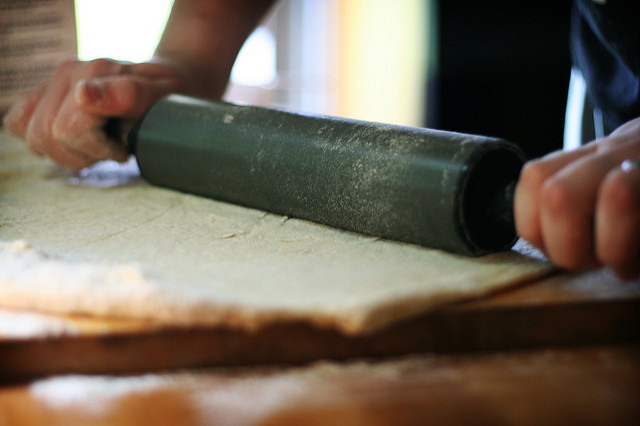
Eating disorders aren’t about the food. They’re about the fear, shame, judgment, anxiety, lack of self, and a whole host of other difficult emotions that manifest themselves through food and weight—not about the food.
Except when they are.
Because there comes a point when, whatever form of disordered eating you may be suffering from, you have to get on with facing your fears and commit to eating in a way that’s right for your body. Generally, most people have a good basic idea of what a balanced diet looks like, but it can be hard to put that into practice. Sometimes, it takes a little support, be that from a charity like NEDA, a body-positive community like Health at Every Size, or an online resource like, ahem, Adios Barbie.
Eating & Living is a recipe book for those in recovery from eating disorders—by those who have been there. This collection of recipes was created by people recovering or recovered from an eating disorder, as well as health experts, professionals, carers, friends, and family of sufferers. Each of them provided a personal recipe for the book—and each of them told the story of why this recipe matters.
The idea for Eating & Living came from conversations on an inpatient ward for eating disorder treatment, where I spoke with other patients about meals we loved and wished we felt able to eat again. As we told stories about those delicious foods we feared we had lost, we joked about how we should make a recipe book, what with all the food knowledge and meal ideas we had. These conversations were not solely about the food—great meals are often associated not just with taste and texture, but also with the circumstances that made them, the memories associated with them, and the feelings they evoke. Every meal we discussed had a story.
When I decided to actually make this book happen, I wanted people not only to give me a list of ingredients and step-by-step instructions, but also to tell that story. There are meals that evoke memories of childhood, those tried for the first time in recovery, those lost in years of illness and later found again.
It’s inspiring to read how Tabitha Farrar fought her fear of fat and rediscovered cheese on toast, or how Jessie Moore of Cake Spy can now bake and eat delicious sweet creations and knows when her body needs them. Shani Raviv tells of how rediscovering her granny’s mac ’n’ cheese allowed her and her grandmother to bond again, and former model Nikki DuBose shares her recipe for bread, which now when she eats reminds her that her body is special and worthy.
Eating & Living contains a whole mix of recipes with a variety of ingredients for different mealtimes, tastes, and budgets, and the meals are broadly balanced to try to address the nutritional and physical aspects of recovery. The book communicates that there is no such thing as a “good” food, and that everything in moderation is OK, positive, and necessary in a healthy diet. When asked to contribute a recipe, I was given broad guidelines: no undressed salads or deep-fried Mars Bars, but anything in between that has some meaning to it was fine. Meals are meant to be an important and enjoyable part of a happy life, but sometimes it can be hard to remember that.
Anyone who’s ever had a meltdown in the supermarket or stood in front of an open fridge for hours will know that some of the biggest challenges of eating during recovery come with grocery shopping, planning meals, and facing the cooking. The book contains tips and support from nutritionists and dieticians on how to tackle those challenges, too.
For example, if picking a sandwich for lunch feels too hard, then choose one attribute such as the filling. “Today I fancy chicken.” And then the first one that is chicken is yours—regardless of if it’s chicken and sweetcorn, or chicken and mayo, or chicken and sweetcorn mayo, or anything else. I’ve tried and tested this technique after spending 90 minutes in the “quick” sandwich aisle in Tesco, picking up and putting back every single one of the 100 or so options—and then deciding my life and time are too valuable for this.
Another favorite tip: If the meal you’re about to eat seems terrifying, try having only one component of it be a fear food, and make the rest more familiar. And while portion sizes are valuable to make sure you’re getting enough, remember not to get too caught up in exact measurements. Some apples will be bigger than others. Sometimes you’ll have more milk on your cereal. That’s OK!
The money raised from sales of Eating & Living will go to B-EAT, the UK’s national eating disorder charity. B-EAT provides helplines, online support, and a network of UK-wide self-help groups to help adults and young people in the UK beat their eating disorders. They campaign, raise awareness, organize events, and offer support to change the way we think and talk about eating disorders, improve services and treatment, and help anyone believe that their eating disorder can be beaten. They believe in recovery —and this book will help you get there.
You can purchase Eating & Living from the usual online book retailers, or you can check here to find out where to buy to maximize your donation. And if you want more information, drop me a note or a tweet.
I hope that the book will be not only a used resource, but also a symbol. A testament to resilience, hope, and the belief that recovery is possible. Recovery is hard. But to live, you must eat. And it’s possible to overcome the disorder and do it.